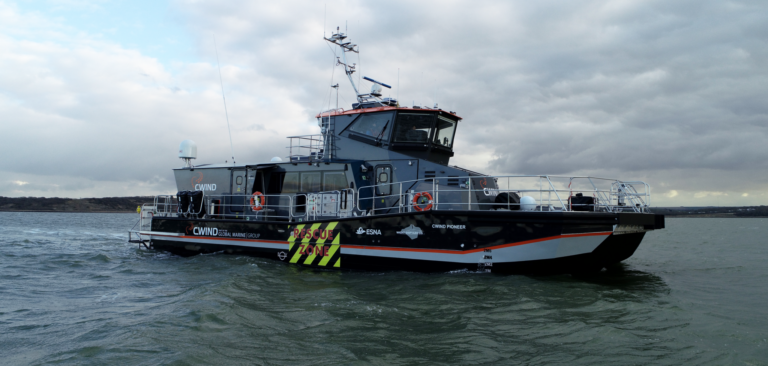CWind, a provider of project services, CTVs and GWO-accredited training courses to the offshore wind industry, has delivered what it says is the world’s first hybrid-powered Surface Effect Ship (SES), the CWind Pioneer.
The vessel was developed in response to an industry-wide push to deploy innovative technologies that reduce CO2 emissions, while cost-effectively servicing windfarms located further offshore. The company says the Pioneer achieves this through the use of a hybrid diesel and battery-electric power system, enabling the vessel to operate purely on battery power while in harbor or at standby at a windfarm.
With surface effect hull form and heave compensation technology, the CWind Pioneer’s builders state it can operate at speeds exceeding 43.5kts, and can transit and transfer safely in sea states in excess of 1.8m Hs, while minimizing motion and acceleration through its air cushion motion control system. The propulsion system can also deliver sprint speed and extreme bollard push using its 1,600kW diesel engines, which can be battery boosted up to 1,800 kW.
At a speed of 43.5kts, the Pioneer is over 20% more fuel efficient than conventional CTVs running at 24kts on a mile-for-mile basis, CWind says. For a typical windfarm situated 30 nautical miles from port, this translates to a reduction of over 110 tons of CO2 per vessel, per year.
This figure excludes the savings of the hybrid system, which will allow the vessel to be zero-emission ship infield while technicians are carrying out their work on the turbines. The company states that specific figures will be shared once these savings are proven, but initial desktop studies suggest a 30-50% saving over conventional vessels.
Nathanael Allison, managing director, CWind, commented, “The launch of the CWind Pioneer marks a significant milestone for the industry and helps pave the way towards achieving net zero targets. The vessel utilizes revolutionary technology to meet the needs of the market and our customers who want a greener, safer and more efficient Crew Transfer Vessel to support their commercial and green objectives. With the CWind Pioneer we have delivered just that – a new generation of CTVs.”
The vessel will be used at the Borssele 1 and 2 offshore windfarms through a long-term charter contract agreement with Ørsted.
The ship was developed in partnership with ESNA, based in Kristiansand, Norway. ESNA specializes in low-emission technologies and surface effect ship development, and was built by Wight Shipyard, a UK aluminum and high-speed craft vessel builder.



